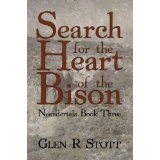Having just finished Search for the Heart of the Bison: Neandertals Book Three, I’m happy to share that it was a fantastic conclusion to the Neandertals trilogy written by Glenn R. Stott.
In Heart of the Bison: Neandertals Book One, Stott provided us with a unique story of how Neandertals and Cro-Magnons lived on this planet. Stott took historical and scientific facts, and blended them into a well-written and descriptive tale.
In Spirit Fire: Neandertals Book Two, Stott gave us an interesting take on Neandertals and Cro-Magnons attempting to live in harmony. He then provided us with a believable hypothesis as to what a war for survival would have been like between these two very different races and cultures.
Finally, in Search for the Heart of the Bison: Neandertals Book Three, Stott wraps up this three-part tale by bringing us forward through the ages; using our archaeological discoveries and scientific suppositions to do so.
Sandi Hartwell, a novice archaeologist, gets the break of a lifetime at a dig in northern Pakistan. She has always had an unexplained ‘sixth sense’ about the earth and its geology – consequently she discovers what appears to be fossil evidence of a Neandertal and Cro-Magnon pairing and their offspring. Is the world even ready for a discovery of this magnitude? Of course, she isn’t the only one interested in this find. She and her team will have to battle terrorists, the unknown, and even the known. At the end of it all, Sandi will need to re-evaluate what she thought she knew about, well, everything.
In summary, Stott does a great job of mixing fact with fiction – as well as providing some ‘humorous’ explanations for a few of society’s unkind idiosyncrasies. Search for the Heart of the Bison: Neandertals Book Three was certainly a fun read. The tale was unique and interesting. The characters were (for the most part) believable and I enjoyed the ‘what if’ aspect of the story. Throughout the entire Neandertals trilogy, there has always been underlying (and important) message about all civilizations living together in peace and harmony. While none of these books provide a detailed road map on how to achieve this elusive aspiration, they do provide the reader with interesting food for thought.
